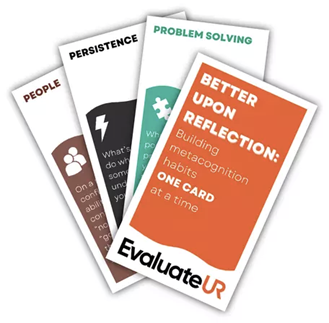by Roman Taraban, Texas Tech University
In linguistics, a register is a variety of speech used for distinct purposes in particular social settings. In a manner consistent with that terminology, I am here using the term discourse register to refer to sets of specific terms and meanings, and to specific vocabularies used by groups in order to achieve distinct purposes. Unlike a dictionary, a register is not so much concerned with the meanings of words as it is with their association with cognitions, affects, and behaviors. A discourse register can link together such disparate phenomena as hate speech, PTSD, and metacognition by virtue of the fact that each has a distinct discourse register, that is, each applies a specific vocabulary and manner of speech. The purpose of this blog post is to suggest that these disparate phenomena are similar by virtue of the way that they operate. The second purpose is to suggest a way of increasing our understanding of metacognitive processing by beginning to implement some of the technology that has already been extensively applied to hate-inspired webforums and trauma-related therapies.
Regarding hate speech, the internet has provided radical right groups the means to organize networks that often promote bias, bigotry, and violence. An example is Stormfront (https://www.stormfront.org/forum/), which was established by white supremacist and ex-felon Don Black in 1996. (Figea, 2015). Right-wing extremists use the internet to build identity and unity with “like-minded” individuals. This has prompted researchers and government analysts to analyze extremist communications in order to gain an understanding of these groups. Importantly, key indicators in the communications are sought out that could indicate future events (Figea, 2015; Figea et al., 2016).
What are the key indicators in extremist communications? The answer lies in part in the concept of a discourse register. It consists of the specific vocabulary and ways of communicating that characterize the shared conversations and practices of a group. For example, Figea (2015) applied machine learning to analyze Stormfront forum exchanges in an attempt to assess the level of three affects: aggression towards an outgroup, racism, and worries about the present or future. A sample of forum posts was classified by humans for the affects, then a machine was trained on the human classifications and tested on a new sample of forum posts. Key indicators for the racism affect were black, race, Jew, protest, and Zionist, corresponding to topics in the forums associated with Black inferiority, Jewish conspiracy, and government corruption (Figea, 2015).
The idea of a shared discourse among a group of individuals provides the theoretical glue that allows binding the activities, speech, and shared identity of groups of individuals. In some cases, the analysis of discourse has provided insights into the motivations and behaviors of extremist and terrorist groups, as described by Figea and colleagues (2015; Figea et al., 2016). In other cases, researchers have applied the idea of discourse and discourse analysis to prosocial activities involving counseling and therapy. Pennebaker and King (1999) proposed that “the way people talk about things reveals important information about them” (p. 1297). In order to assist them in their analyses, Pennebaker and colleagues developed and tested the LIWC (Linguistic Inquiry and Word Count) software. This software has been successfully applied to the analysis of texts in a variety of contexts and applied to a wide range of dimensions. These include analyses of emotionality, social status, group processes, close relationships, deception and honesty, thinking styles, and individual differences (Tausczik & Pennebaker, 2010).
Jaeger et al. (2014) examined the associations between trauma-related experiences (e.g., PTSD, depression, anxiety) and the content of the narratives written by trauma patients. The researchers found significant differences between daily vs trauma-related narratives in the use of cognitive-mechanism words (e.g., cause, know, ought) and negative emotion words (e.g., hate, worthless, enemy). There were also strong associations between the words that patients used and the severity of their trauma. The approach and outcomes in Jaeger et al. was similar to that employed by Figea and colleagues.
A perk of the LIWC software is that it allows individuals to develop their own specialized dictionaries and to import those dictionaries into LIWC to analyze language use for evidence of the target constructs. When individuals express sadness, they use words like sad, loss, cry, alone (Pennebaker & King, 1999). Sadness is part of a person’s emotion register. Can we apply this analytic approach to metacognition and ask, What is the discourse of metacognition? As instructors, how do the ways we talk about teaching reflect a metacognitive register – i.e., words that reflect an understanding of cognitive functioning, learning, limitations, self-regulation, monitoring, scaffolding, and so on. How do the ways we talk about students, classrooms, homework, and student collaboration mirror metacognitive understanding and processing? Current technology allows us to begin exploring these questions. Following the model provided in Figea (2015; Figea et al., 2016), one place to start might be this Improve With Metacognition (IWM) forum. The analysis of published scholarship on metacognition would be another source of texts to use to train and analyze a machine to detect key metacognitive indicators in texts. Human coders would code sentences in a sample of the texts as involving or not involving metacognition. These classification would be used to train a machine. After training, the machine would be tested on a new sample of texts.
Development of a metacognitive register is subject to the same constraints as any good scholarship. The developers need to be experts in the area of metacognition, and they need to have a clear grasp of how metacognition works. The linguistic analysis dictionary that they develop needs to be accurate and comprehensive. It needs to be a team effort – one individual cannot do it alone. The dictionary needs to be tested for construct validity, internal consistency, and for reliable test results across a variety of participants and contexts. In spite of the challenges inherent in the task, the prospect of a ready analytic tool for metacognition could help in advancing the application of the powerful cognitive suite of metacognitive processes in classrooms.
References
Figea, L. (2016). Machine learning for affect analysis on white supremacy forum. Downloaded from https://uu.diva-portal.org/smash/get/diva2:955841/FULLTEXT01.pdf .
Figea, L., Kaati, L, & Scrivens, R. (2016). Measuring online affects in a white supremacy forum. In IEEE Xplore. DOI: 10.1109/ISI.2016.7745448
Pennebaker, J. W., & King, L. A. (1999). Linguistic styles: Language Use as an individual difference. Journal of Personally and Social Psychology, 77(6), 1296-1312.
Tausczik, Y. R., & Pennebaker, J. W. (2010). The psychological meaning of words: LIWC and computerized text analysis methods. Journal of Language and Social Psychology, 29(1), 24-54.



